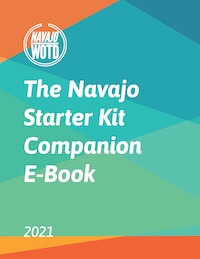ashą́
to eat
ush sha
The Navajo word ashą́ is the first-person form of the continuative imperfective verb “to eat.” Or, it can be said that this verb paradigm is the “is eating” paradigm, denoting that eating has begun and is ongoing (in contrast to “did eat” and “will eat,” and others).
Here are the other words for this paradigm:
- Ashą́ (I eat)
- Íyą́ (You eat)
- Ayą́ (He eats)
- Iidą́ (We two eat)
- Ohsą́ (You two eat)
- Ayą́ (They two eat)
- Da’iidą́ (We three, or more, eat)
- Da’ohsą́ (You three, or more, eat)
- Da’ayą́ (They three, or more, eat)
| 1. Ashą́ (I eat) | 4. Iidą́ (We two eat) | 7. Da’iidą́ (We three, or more, eat) |
| 2. Íyą́ (You eat) | 5. Ohsą́ (You two eat) | 8. Da’ohsą́ (You three, or more, eat) |
| 3. Ayą́ (He eats) | 6. Ayą́ (They two eat) | 9. Da’ayą́ (They three, or more, eat) |
Example: Shí dóó Jerry bá’áłchíní éí Mary bighandi da’iidą́.
Me and Jerry’s children, at Mary’s house, we are eating. (Verbs generally follow the object, which follow the subject(s)).
